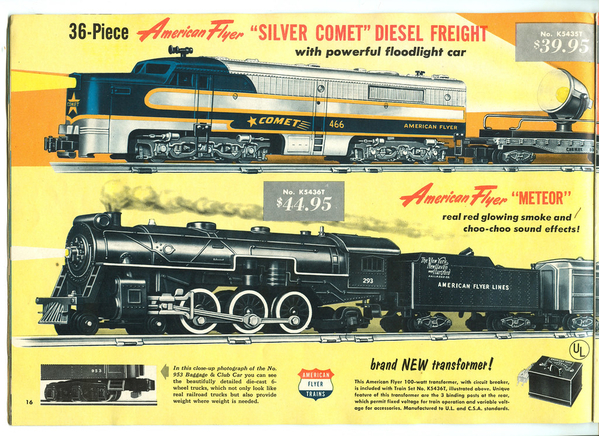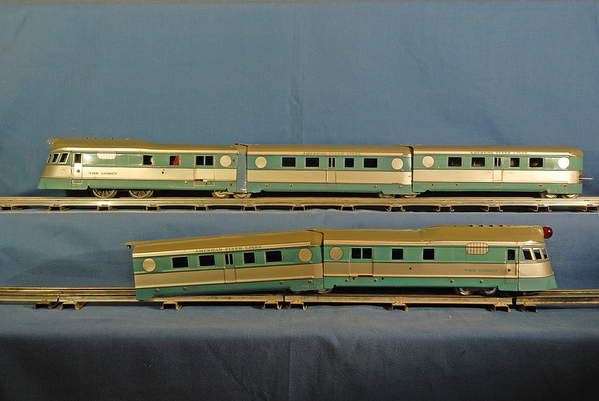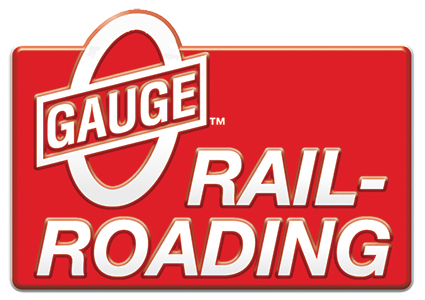While browsing Ebay, looking for more Lionel stuff to buy, or should I say sneak into the house, American Flyer pre-war stuff comes up quite often. The thought occurred to me that if AF had stayed with three rail "O" gauge, they may have captured more of the market in the post-war years from Lionel. Any thoughts ?
Replies sorted oldest to newest
It seems like the later models should run smoothly at realistic speeds, since they have a “tight” worm gear drive. A long time ago someone advised me that they weren’t good pullers. Also, it’s hard to find examples with intact wheels. The pilot and trailing wheels especially seem to crumble from zinc pest.
I grew up with O27 trains, so I’m not a stickler for scale proportions. But the bodies are noticeably small for O-gauge track (they remind me of English trains), and I think they would look small next to traditional Lionel postwar and MPC rolling stock.
I don’t own any, and you’re right- I don’t know of any good reference books on Prewar Flyer.
Ted S posted:It seems like the later models should run smoothly at realistic speeds, since they have a “tight” worm gear drive. A long time ago someone advised me that they weren’t good pullers. Also, it’s hard to find examples with intact wheels. The pilot and trailing wheels especially seem to crumble from zinc pest.
I grew up with O27 trains, so I’m not a stickler for scale proportions. But the bodies are noticeably small for O-gauge track (they remind me of English trains), and I think they would look small next to traditional Lionel postwar and MPC rolling stock.
I don’t own any, and you’re right- I don’t know of any good reference books on Prewar Flyer.
Ted, are we on the same subject ? No disrespect meant.
I do have prewar flyer, most especially the streamliners. No one carried these into the postwar era. Lionel, Hoge, AF, etc. The only problem I have is the reversing, and specifically auto reverse. Because of their little
legal dispute with Lionel, Af came up with some creative auto reversing. I think on any given day Af
was right up there with Lionel in the prewar era. And a lot of times better.
Dan Padova posted:The thought occurred to me that if AF had stayed with three rail "O" gauge, they may have captured more of the market in the post-war years from Lionel. Any thoughts ?
No, I don't think Flyer could have successfully competed with the powerhouse that was Lionel in the 3-rail market in the early Fifties. IMO, Gilbert made the right decision in trying to carve out their own niche with S scale.
Unfortunately for us all, the rapid downturn in train sales that struck in the late Fifties killed American Flyer in the cradle. S scale never really got the chance to become a major player. It is slowly regaining adherents today, but S scalers are still very much in the minority.
My feeling is that 3-rail Flyer would have disappeared altogether before 1960.
Dan sorry for any confusion. My post was referring to the 3/16” scale proportioned steam locos American Flyer made for 3-rail O gauge circa 1940. I’ve looked at them with curiosity many times myself. I’m pretty sure they would run slower and with more control than any of Lionel’s traditional-sized prewar locos like the 1666, etc.
Some of them (such as the Reading Atlantic) morphed into the well-known American Flyer S-gauge after the war.
Dan , I believe that you are right that American Flyer O-Gauge three rail would have been able to give Lionel some decent competion in the post war era . You have to remember that Lionel only made it through the depression with the help of Disney and Mickey Mouse .Those one dollar hand cars sold well . W.O. Coleman and the gang from Halsted street in Chicago were not so lucky . In 1932 , a President's Special wide gauge set sold for $100 and a Mayflower set set you back a whopping $150.Not a lot of takers back then . The American Flyer name and factory was sold to A.C. Gilbert in 1937. And as they say , the rest is history . I think that they were on a par with Lionel in the Teens and Twenty's and had they survived , They may have been as innovated as Lionel was in the post war era.
Summerdale Junction posted:Dan , I believe that you are right that American Flyer O-Gauge three rail would have been able to give Lionel some decent competion in the post war era . You have to remember that Lionel only made it through the depression with the help of Disney and Mickey Mouse .Those one dollar hand cars sold well . W.O. Coleman and the gang from Halsted street in Chicago were not so lucky . In 1932 , a President's Special wide gauge set sold for $100 and a Mayflower set set you back a whopping $150.Not a lot of takers back then . The American Flyer name and factory was sold to A.C. Gilbert in 1937. And as they say , the rest is history . I think that they were on a par with Lionel in the Teens and Twenty's and had they survived , They may have been as innovated as Lionel was in the post war era.
I believe the whole Mickey Mouse saving lionel is a myth from what I have read. I don't think
Lionel made enough from Mickey mouse to buy a pack of gum after manufacturing costs etc.
I think it was the M10000 and forward looking trains like that that really got Lionel back on track.
Ted S posted:Dan sorry for any confusion. My post was referring to the 3/16” scale proportioned steam locos American Flyer made for 3-rail O gauge circa 1940. I’ve looked at them with curiosity many times myself. I’m pretty sure they would run slower and with more control than any of Lionel’s traditional-sized prewar locos like the 1666, etc.
Some of them (such as the Reading Atlantic) morphed into the well-known American Flyer S-gauge after the war.
All of the Flyer 3/16ths O gauge body shells and tenders made the transition from 3 rail O gauge to S gauge. There were a couple wheel arrangements that bit the dust (a B&O Royal Blue 4-4-2 and a PRR K-5 4-4-2 didn't make the transition). They engines' boiler shells are a little wider than true S scale size so the steamchests looked ok riding on O gauge track. No traction tires on the worm drive models, the Hudson and Challenger (UP 4-8-4) came in early versions with spur gear drives and I believe some Hudsons had traction tires. My friend Art Shifrin loved 3/16ths O gauge Flyer and had a beautiful layout which he populated with custom paint job models; he also had a machinist who would modify drivers so they could accommodate traction tires. Here's a link to some of Art's Flyer customized models: https://web.archive.org/web/20...s/customizations.asp
The stamped metal freight and passenger cars weren't very detailed and roll so-so, the diecast freight and passenger cars look really nice but are prone to zinc pest (Dorfan's Disease) and can be found intact, warped, bowed, crumbling or varying combinations of destruction - they also weigh a ton, aren't very good rollers and limit the length of train you can run. One nice way to supplement 3/16th O gauge Flyer consists is to consider running Marx 3/16ths O gauge cars; the couplers are completely different, but you can swap a Flyer truck onto a Marx car to make a transition car. A little Marvel Mystery Oil on the axles allows the Marx cars to roll much better. Marx's litho work is gorgeous and they offered nice variety of car styles as well. The 999 2-4-2 and 333 Pacific are 3/16ths O gauge proportioned as well and look good with Flyer's offerings.
Here's a thread over at CTT that does a nice job at describing Flyer's 3/16ths line: http://cs.trains.com/ctt/f/95/t/211963.aspx?page=1
I have had only one opportunity to examine a 3 rail American Flyer prewar O gauge set. I finally found the pics.....it was in late 2015. Really nice stuff.....the "might have beens" are always interesting to consider.....
Here are the pics.....note the zinc rot on the steamer.....
The red Christmas bulb simulating the firebox is a nice touch.....
Have a great weekend folks......
Peter
Attachments
I have the same (almost) set except for the dump car and its from 1940-41 as best I have been able to research. I also have an engine but its a 2-4-2 and smaller than the one in Peter's entry above and also is a shelf queen. The cars would look a little "small" when run with Lionel scale or other O scale trains because they were made at 3/16" scale but O-gauge as opposed to 1/4" O scale. I also agree pulling them with a Marx loco and scale cars which also approximated 3/16 " scale, when you can determine the scale at all, and the listed ones 999/666 are great runners but don't forget the 333 or 1869 . Yes you have to create a "transition" car to alter the couplers but a common Marx flat car and a little work will do this. Note- candidly when in a hurry I have taken care of this with a "band aid" of a little wire wrapped around the coupler from the tender to the first car sort of tying them together (yes I agree its crude but it does work).
Don
American Flyer 3 rail O gauge probably would not have survived in the post war years for a number of reasons, but while they were produced they were beautiful.
Chicago era
Gilbert era
Chicago Great looking toy train
Chicago era streamliner
Chicago era soulmates
Minnehaha and Hiawatha
The Royal Blue
I got a bit carried away. All of my trains are packed away following a recent interstate move. I miss seeing them. LOL
Northwoods Flyer
Greg
then you better get off the 'puter Greg and get to hanging shelves and unpacking trains!
A little off subject but I think American Flyer made a good move when they did S gauge. They knew the could never catch Lionel. They advertised true scale trains but they never went all the way. Those silly wide white tires on all their steam engines, American Flyer plastered on all the engines and cars, diesels with names like Rocket or Comet just didn't look right. Even as a kid I thought they missed the boat. I think they could have put a dent even with the HO crowd if they really did scale trains. Don
Attachments
beardog49 posted:Summerdale Junction posted:Dan , I believe that you are right that American Flyer O-Gauge three rail would have been able to give Lionel some decent competion in the post war era . You have to remember that Lionel only made it through the depression with the help of Disney and Mickey Mouse .Those one dollar hand cars sold well . W.O. Coleman and the gang from Halsted street in Chicago were not so lucky . In 1932 , a President's Special wide gauge set sold for $100 and a Mayflower set set you back a whopping $150.Not a lot of takers back then . The American Flyer name and factory was sold to A.C. Gilbert in 1937. And as they say , the rest is history . I think that they were on a par with Lionel in the Teens and Twenty's and had they survived , They may have been as innovated as Lionel was in the post war era.
I believe the whole Mickey Mouse saving lionel is a myth from what I have read. I don't think
Lionel made enough from Mickey mouse to buy a pack of gum after manufacturing costs etc.
I think it was the M10000 and forward looking trains like that that really got Lionel back on track.
No myth here .Check this out: https://www.waltdisney.org>blog>Disney-and-lionel
Well that's the Disney version but it's not Lionel's version. Lionel didn't dissuade the story because it's a good story but they have often stated it really didn't save the company. Don
Summerdale Junction posted:Dan , I believe that you are right that American Flyer O-Gauge three rail would have been able to give Lionel some decent competion in the post war era . You have to remember that Lionel only made it through the depression with the help of Disney and Mickey Mouse .Those one dollar hand cars sold well . W.O. Coleman and the gang from Halsted street in Chicago were not so lucky . In 1932 , a President's Special wide gauge set sold for $100 and a Mayflower set set you back a whopping $150.Not a lot of takers back then . The American Flyer name and factory was sold to A.C. Gilbert in 1937. And as they say , the rest is history . I think that they were on a par with Lionel in the Teens and Twenty's and had they survived , They may have been as innovated as Lionel was in the post war era.
AC Gilbert did not purchase the Flyer Factory on Halsted Street, as W.O. Coleman did not own the building and was leasing it. AC Gilbert purchased the name and tooling and any remaining inventory. He had all of the tooling/equipment moved to New Haven after the purchase.
As stated, American Flyer (in Chicago) was barely hanging on in the late 1930s and likely would not have survived to WWII, as W.O Coleman passed in 1939.
scale rail posted:A little off subject but I think American Flyer made a good move when they did S gauge. They knew the could never catch Lionel. They advertised true scale trains but they never went all the way. Those silly wide white tires on all their steam engines, American Flyer plastered on all the engines and cars, diesels with names like Rocket or Comet just didn't look right. Even as a kid I thought they missed the boat. I think they could have put a dent even with the HO crowd if they really did scale trains. Don
How true Don. I too, could never figure out why Flyer used such fictitious unrealistic names.
Comet was a real train, Flyer even made a prewar model of it. The S gauge
one bears no resemblence.
Yes, the Comet was a real train - but I think the point of the original comment was that no Alco ever had that livery and I agree - even though I was a Lionel kid I always thought my friend's Comet looked odd.

















